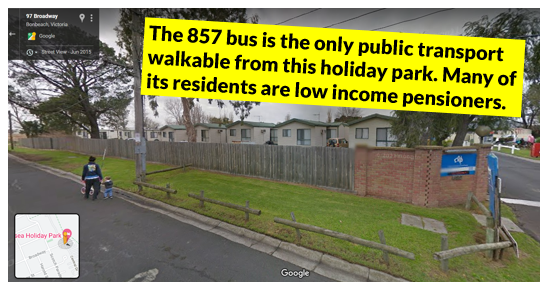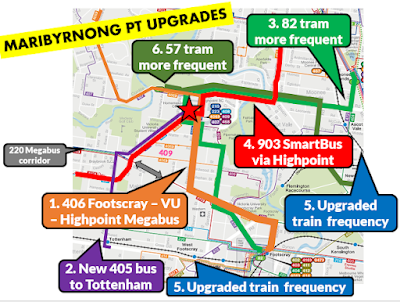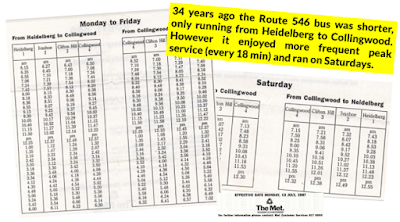When it comes to growth area bus upgrades, some areas have done better than others. Tarneit has recently seen two new bus routes added with two more to come. In the south-east Clyde North has also seen upgrades and new routes to serve previous large coverage gaps. The outer north around Craigieburn saw the new 525 and will, in a couple of days, the new 390 across to Mernda. And next month it's back to the 525 with frequency upgrades to plug large gaps in its timetable.

Areas around Melton and Pakenham townships, also growth areas, have seen much less love for buses. Hence they present significant opportunity for improved routes and timetables. Even the opening of the new station at Cardinia Road in 2012 was insufficient to trigger a bus revamp. Subsequent spending
has been all about park & ride. Hence we still have unreformed bus routes like the
925 that stop just short of the station, requiring significant backtracking for the hardy few willing to use it. Other local bus issues are mapped below:
Network reform challenges
So much for the problems. What about some solutions?
I described an
extended and upgraded Route 928, south of the railway, last year. Hence today I'll concentrate on north side bus network reform. But not exclusively.
Pakenham comprises three main east-west corridors. Two road and one rail. All enable transport along them but present substantial walkability access barriers across. The extent of this depends on the choice of corridor. For instance limited access freeways and at-grade railways with few crossings are least permeable.
Inner suburbs like Northcote and Brunswick, and even outer (but old) suburbs like Chelsea were built with many crossing points across their railways. Back then walking was considered essential transport, not just an optional recreation. Hence it was embodied in the transport system. We were also good at building bridges (numerous but narrow) so that rivers and creeks did not much hinder access.
Today's designers take 80 - 100 km/h driving rather than 4-5 km/h walking as the norm. Bridges are rarer but wider. Human scale considerations invariably get ignored for new freeway and railway alignments, which now impose almost as much severance as rivers.
Even if the railway alignment is old, such as it is to Pakenham, if newer suburbs sprout up around it then only a few new crossings are put in. Generally these are for coarse road grids or near station precincts. Away from these there will be large gaps of several times the maximum (say 400m) needed for a permeable community. This is a particular concern given the increased density we are now building outer suburbs as it locks them into car dependence even for local trips.

Limited permeability can shape bus network access. While we normally think of buses crossing and feeding rather than paralleling trains, Pakenham's wide spacing of stations means that buses do need to parallel the line and may run near it. Impermeable railways or roads can compromise bus coverage and mean that people have less choice of route than they should. This is a particular consideration here as buses are hourly or worse.
What other considerations would shape the local network? There are no major destinations significantly north and south of Pakenham for a long long way. But the corridor is about 4 or so kilometres from north to south with Princes Hwy and the railway being roughly down the middle. That is poor for walking but may be OK for biking if there were good off-road paths (which there aren't). Buses are thus necessary, with most routes joining the widely spaced stations on the Pakenham line and running parallel to the line north or south of it to pick up residential and other coverage.
This is more easily said than done. Unlike a greenfields development, Pakenham was built around a long established centre with growth over 40 or more years. Road alignments may not have anticipated the continuous growth of suburbia. Bridges may remain unbuilt and estates may not connect with each other. It may be difficult to route buses that neither leave large areas unserved nor inefficiently overlap others. The map below shows some of the challenges.

A revised network
The above challenges means that, unlike in some other areas, a new network doesn't automatically seem to draw itself. Despite routes being indirect a new network is unlikely to be practical without new buses being bought to improve coverage and frequency since the latter is currently so low (hourly or worse).
Pakenham, unlike Wyndham, has a single tier bus network. That is all routes are similarly infrequent. The big change in the Brimbank 2014 and Wyndham 2015 reforms was to introduce a two tier network with some routes operating every 20 minutes, preferably seven days per week. Other routes would typically operate every 40 minutes, though some have a 20 minute peak frequency.
What might such a network look like for Pakenham? We already have the train with services typically every 20 minutes. But stations are widely spaced so the vast majority only get an hourly bus that might not even run to the nearest station.
Despite being walking hostile in parts, Princes Hwy looks the obvious corridor for the area's first main bus corridor with many destinations along it. Much of it has the 926 which is the area's most productive bus route. However the 926 veers off Princes Hwy in two places between Cardinia Rd and Pakenham. This together with its hourly frequency makes the 926 more a hybrid local/trunk route rather than a frequent and direct main route. This may have been appropriate in the past but growth means that it is not so now. A simpler network would likely include the 926 sticking to Princes Hwy with another route to provide 'mop up' local coverage between at least Cardinia Rd and Pakenham.
That's the north side. On the south side could be an upgraded and extended 928, as
discussed last year. The path is less defined than Princes Hwy but it would still be relatively direct and provide substantial access to a semi-frequent service.
A concept map is below.
Note that local routes are concepts only and one or two more may be required for acceptable coverage. Though not clockface an off-peak frequency of 40 min would provide greater travel flexibility than the current hourly service. Peak service might be in the 20 to 30 minute range, ie 2 or 3 times better than now. As the area develops and areas around Officer fill in some local route may extend to destinations such as Berwick and Narre Warren to provide better access to regional scale education, hospitals and shopping in that area.
Stage One
The first stage lays the groundwork for a two tier network and addresses the silliness of the 925 stopping short of its nearest station. The centrepiece is the reformed 926 which I've called the 930. This becomes the top tier route in the area, running along Princes Hwy. The 926 survives as a local route operating along its existing alignment between Pakenham and Cardinia Rd with the option of an extension north of Princes Hwy to the Kenneth Rd area if run time allows. No stops would be removed except for near the 925 terminus (which would gain an alternative nearby).

Route 926's scheduled run time is 45 to 50 minutes, permitting the existing hourly service with two buses. If shortening the route reduces the run time to under 40 minutes then the two buses could allow a frequency increase to every 45 minutes with those two buses on the 930 mapped above. 45 minutes is neither clockface nor does it mesh with 20 minute trains. A 40 minute frequency is not clockface, still insufficient for a main route but could mesh with the existing 20 minute train service. If run time is not sufficiently below 40 minutes to allow this, there may be scope to interline with other routes at Pakenham or Fountain Gate.
Upgrading the 930 to a 'Useful Network' route every 20 minutes would be desirable. Three extra buses should comfortably enable this provided that the streamlined and more direct highway route is adopted.
Whatever service level is chosen with the 926, one extra buses will be needed for this new local-only route. Depending on whether the added coverage at Kenneth Rd is provided this could enable a 40 or 60 minute frequency. Not good but the same as or better than other local routes.
The main loss is that some on the shortened 926 will lose their one seat ride to Fountain Gate. However some will be walking distance of Princes Hwy where the 930 would offer a more frequent service. If this is an issue options could include careful scheduling to optimise 926/930 connections and/or backtracking the new 926 into Cardinia Rd station (where interchange to other routes would be possible).
Stage Two
This stage concentrates on routes north of Pakenham Station. It is a bit of a tangled mess, partly due to an unhelpfully indirect road network with too few junctions. You might notice how indirect the 927 and 929 were. The 929 also has a unidirectional loop at the end and a dog-leg just out of Pakenham.
The map below is an attempt to improve directness. Sometimes making one route more direct results in another becoming less direct. However the less direct route may be more local in character or have other more direct routes within walking distance of much of it.
When the 925 started there was no station at Cardinia Rd. When the station was built the bus wasn't extended to it. Stage 1 above makes that extension. An extension, particularly in the city-bound direction, makes high directness in the outbound direction towards a station less critical.
Hence the changes in Stage 2. Here I've swapped the 925 and 927 to make the latter more direct. This helps those in the area where the 927 provides the only service within walking distance. A further straightening of the 927 on the map has routed it via more of Ahern Rd rather than Eagle Dr. There could be scope for 927 to be made even more direct but this would route it further away from Pakenham Secondary.
The 929 has had a kink added in its north-west portion to throw some coverage to the area east of Waterside Drive. Strictly speaking this should go further east but the road layout is unhelpful for good bus coverage.
You will notice the double arrow. The idea here is that arriving Route 929 buses would form inbound 927 trips and vice versa. Thus passengers living near the northern part of the 929 could board a 927 at Pakenham and eventually get home in less time than it takes to wait for the next 929. This has the effect of increasing frequency. Also all of 929 would become bidirectional. The main trade-off is that parts of Army Rd would have only the infrequent 840.

By this time the 930 should be a 20 minute service all day. If not already done so the local routes might be every 40 minutes off-peak with a peak service better than that. Offsetting departures of the 927 and 929 (at least in the peak direction) should enable higher combined frequencies for some.
Stage Three
This does nothing to existing routes except to shorten 926 to finish at Cardinia Rd station. This is replaced by a new route 924. It's a highly indirect coverage mop-up route. No one would ride it end-to-end. But it provides some new north side coverage, connects people to Pakenham Secondary and to the currently unserved business park in the south.
Conclusion
Some new networks I draw I really like. This is not one of them. It still looks too indirect and, apart from the 930, looks too complex. Admittedly a lot is due to the area's disjointed road network. But not all. Not all coverage gaps are filled and I haven't discussed the new Pakenham East precinct (which is getting a station). If you have other ideas please leave them in the comments below.



































